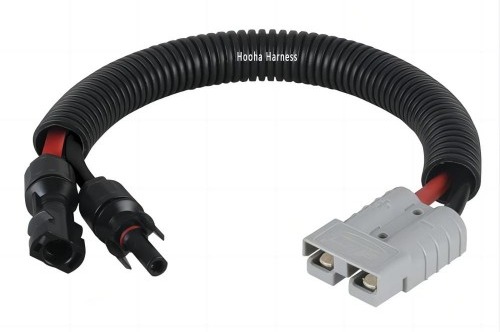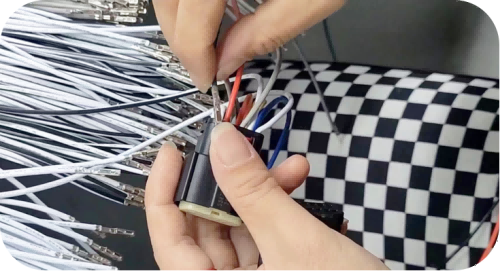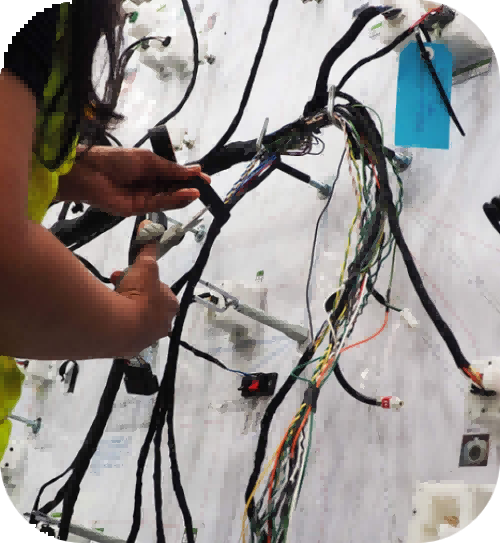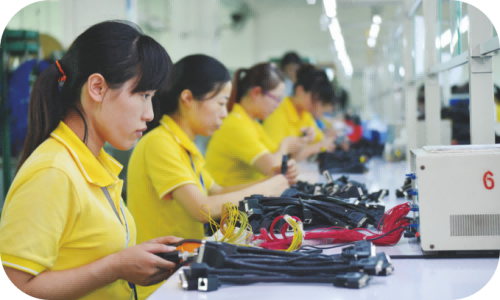wire harness assembly company, Hooha Harness Since 2001
Introduction
Wire harnesses are utilized for transmitting signals or electrical power in a wide range of equipment, tools, and vehicles across various industries such as appliances, heavy machinery, medical devices, and consumer electronics. These harnesses consist of groupings of cables, wires, and subassemblies that can become highly complex to handle multiple branches, safety features, and termination points despite being constructed from three basic components: wires, terminals, and connectors.
Custom wire harnesses are the cornerstone of electronic applications. Manufacturers must construct precise wire harness designs to ensure the optimal efficiency and reliability of their products.

Wire Harness Design and Manufacturing Process
Every wire harness needs to match the geometric and electrical requirements of the device or appliance for which it’s used. Wire harnesses typically are entirely separate pieces from the large manufactured components that house them. This brings a number of benefits, which include:
- Simple manufacturing processes by creating wiring for drop-in installation
- Easy disconnecting and current analysis for troubleshooting, disassembly, and part repair
- Simple installation processes with wire harnesses that include all of a product’s wires, cables, and subassemblies with quick connect/disconnects.
Each wire and terminal can be customized to match the precise length, dimensions, and layout of the primary product it connects to. Additionally, wires may be color-coded and labeled for streamlined installation and maintenance.

The manufacturing process commences with design and schematic development, followed by prototyping, and culminates in production. Operators meticulously assemble wire harnesses on test boards that are drawn out to confirm precise measurements of wire lengths. The board also verifies the use of terminal and connector housings specifically tailored for the application, as well as cable ties and coverings for streamlined organization and transport.

Although automation plays a crucial role in all manufacturing processes, the intricate nature of the final product necessitates that numerous sub-steps of the assembly process be carried out manually. The wire harness cable assembly is an intricate and multifaceted procedure. The primary stages of this procedure encompass:
- Installation of wires, terminals, and connectors onto the building board;
- Incorporation of specialized components such as relays, diodes, and resistors;
- Attachment of cable ties, tapes, and wraps for internal organization;
- Wire cutting and crimping to ensure dependable terminal connection points.
Applications
Wire harnesses are essential components for transmitting electricity and signals in almost all electronic devices and appliances. They simplify manufacturing and maintenance processes across residential, commercial, and industrial contexts according to the hooha harness's specifications. Common applications for wire harnesses include:
- household appliances such as washing machines, dryers, and refrigerators;
- consumer and commercial electronics;
- automotive equipment;
- commercial and industrial machinery;
- medical equipment and electronic devices.
To fully satisfy the diverse range of requirements and regulations demanded by various applications, wire harnesses must incorporate numerous distinct features and capabilities.
We, at hooha wire&cable products company, provide the following capabilities for our wiring harness assembly processes:
- Integration of multiple wire and cable types,
- customized configurations,
- speedy installation times,
- application of multiple interconnects,
- 100% fit, form, and function validation,
- high-speed automated wire processing,
- in-line wire and cable marking,
- harness subassembly prefabrication,
- ultrasonic welding for in-line wire splicing,
- wide range of component options,
- Reverse engineering,
- Unlimited combinations.
Industrial facilities often require custom wire harnesses that adhere to industry standards, such as UL compliance with fire safety regulations. Infrastructural components, including public transit controls and bus timers, necessitate rapid responsiveness and a high degree of precision. At hooha harness, our kits and wire harnesses are custom-crafted to meet the specific needs of our clients without delay.
Compliance with safety standards is a crucial aspect of wire harness design and assembly. hooha harness's wire harness facility holds ISO 9001:2008 certification for safe manufacturing practices, while our operators are certified to IPC/WHMA-A-620 standards and automotive wire harnesses for IATF16949 standard. Additionally, we adhere to UL standards in all of our builds.

Commence your wire harness assembly process today!
Custom wire harness assemblies play a crucial role in ensuring the reliability of electronic systems for residential, commercial, and industrial applications. To discover how our unique expertise can enhance your next wiring system, please contact us today or complete our online form to request a complimentary quote.
